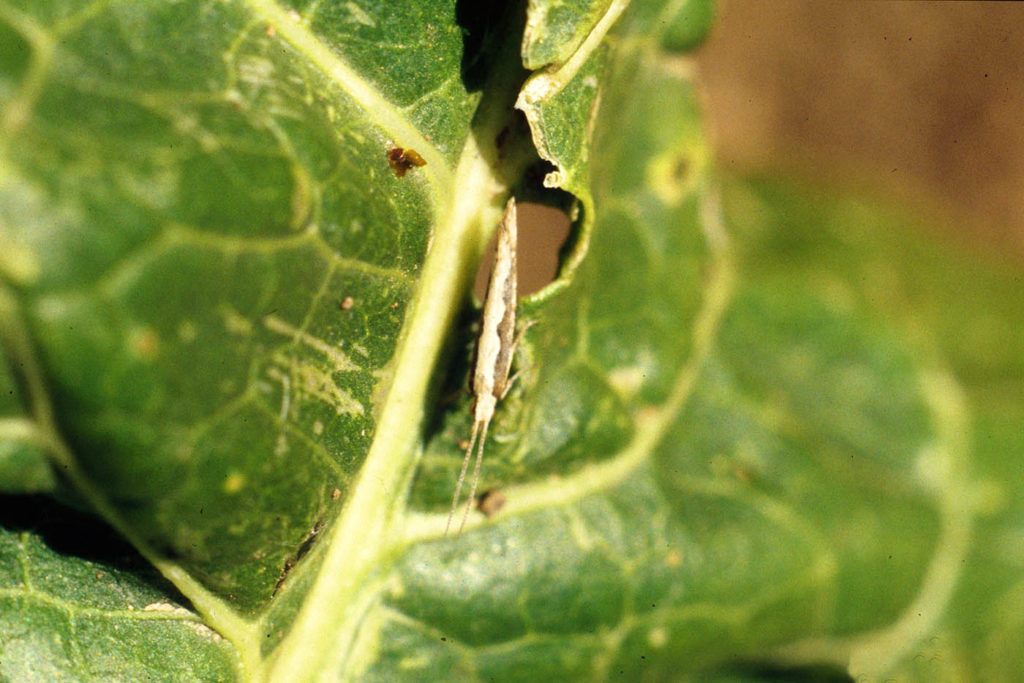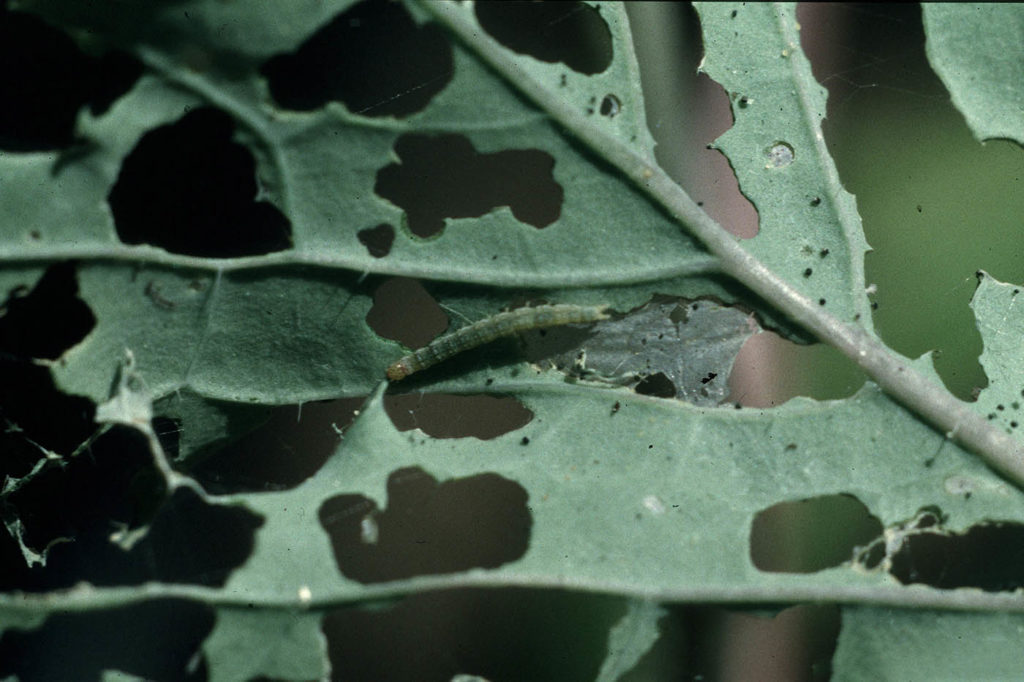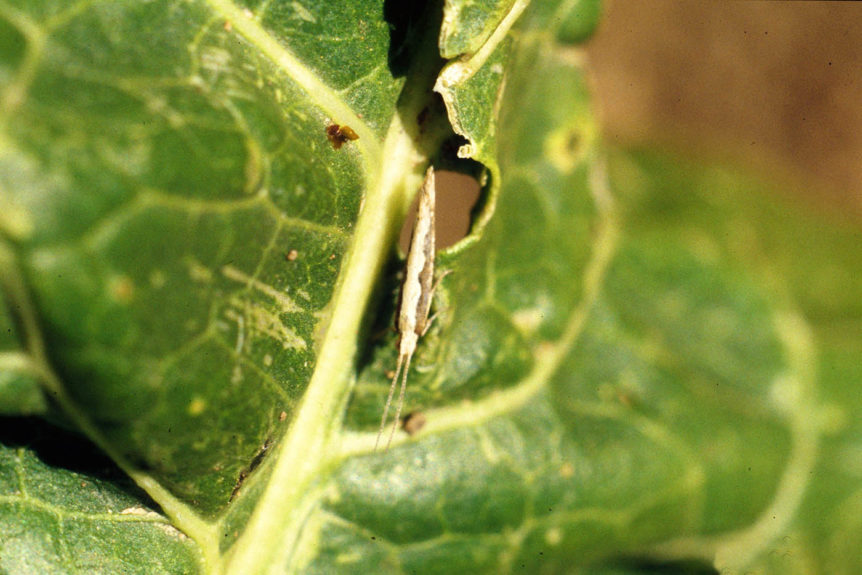
By Frank Giles
For brassica growers, the diamondback moth reigns as the biggest pest problem they must fight. This is particularly true where the crops are produced year-round, like in Georgia. The pest is estimated to cause as much as $5 billion in crop losses every year worldwide.
In the Southeast, cabbage, broccoli and collards are the preferred hosts of the diamondback moth. Other brassica crops can be infested with the pest, but not nearly at the levels of the preferred hosts.
The larval stage of the pest is the most damaging to crops. Feeding creates holes in the brassica foliage and can make plants unmarketable.
Monitoring Recommendations

Scouting is the first line of defense against the pest. In Florida and Georgia, treatment is recommended only when damage equals or exceeds one hole per plant. When growers monitor fields and follow these treatment thresholds, fewer insecticide applications are needed to produce a satisfactory crop, which helps manage resistance. But it can be a fine line of making applications timely enough before larvae can move into cabbage heads and avoid treatment by contact chemicals. That is why systemic insecticides have become more important in treating the pest.
A minimum plant sample size of 40 to 50 is recommended — except during the egg stage, when 150 plants should be examined for accurate population estimates. Pheromone traps can be used to monitor adult populations and may predict larval populations 11 to 21 days later. However, because of variation among locations, each crop field requires independent monitoring.
Tolerance to Treatments
“There are a lot of other pests in brassicas, but diamondback moth is really the one that gives us a problem,” said Hugh Smith, associate professor of entomology and nematology with the University of Florida Institute of Food and Agricultural Sciences. “Diamondback moth is a problem in Florida and globally because it develops resistance to insecticides. So, when you apply just about any insecticide, you can assume that a certain proportion of the population in your field may have tolerance to that treatment.”
Tolerance is passed on to successive generations of the moth by the female population. That means growers should avoid treating successive generations with the same insecticide mode of action. This roughly equates to a 30-day interval.
“With some of the chemical labels, you can apply the same modes of action more than once within that 30-day treatment window, but then in the next 30-day interval you need to use different modes of action to help avoid resistance,” Smith said.
For a crop like cabbage, growth could be broken out into three 30-day cycles. That could coincide with three generations of the diamondback moth. But Smith said that doesn’t necessarily mean you need to start treating diamondback moths as soon as the brassica crop is put into the ground.
Insecticide Options
Those insecticides include Proclaim, Radiant and XenTari. But as harvest approaches, a different mode of action group is needed to break up the resistance cycle. Then in spring, when diamondback moths are most problematic, the treatment scheme changes again.
“In the spring, when we consistently have high diamondback moth pressure, you might want to start off with an at-plant treatment of a diamide like Verimark, because it’s systemic and will have an extended effect. Since it is systemic, you probably only want to apply a diamide once. Whether you apply it once or twice in that first treatment interval, you don’t want to apply it again in successive treatment intervals.”
Growers should pay close attention to the Insecticide Resistance Action Committee (IRAC) modes of action classification. Insecticides in the same group (diamides are group 28, for example) should be rotated appropriately to avoid resistance. Given that brassica crops might need multiple applications in a growing season, this is even more important.
Growers should become familiar with IRAC Groups and plan insecticide sprays based on application timing and product mode of action.
Resistance Research
Smith began collaborative research with the University of Georgia (UGA) in 2018 to survey brassica-growing areas to try to identify patterns of resistance in the diamondback moth. The team of scientists utilized the maximum dose bioassay, which was developed by UGA entomologists Alton “Stormy” Sparks and David Riley. The assay utilizes the highest label rates against field-collected diamondback moth to identify resistance to a range of insecticides.
The research showed that resistance and diamondback survivability to insecticides varied by production region and could vary from year to year. But it reinforced the importance of proactive resistance management.
Research by Smith and his graduate students identified products showing high insecticide mortality after 72 hours of application. These include Proclaim, Radiant, XenTari, Dibrom and Torac. But he cautioned that in some diamondback populations, the pest still did a considerable amount of feeding after the application and consuming enough for a lethal dose.
Visit https://www.youtube.com/watch?v=bN2X7_TtWvg to see more detailed tips on diamondback moth.










